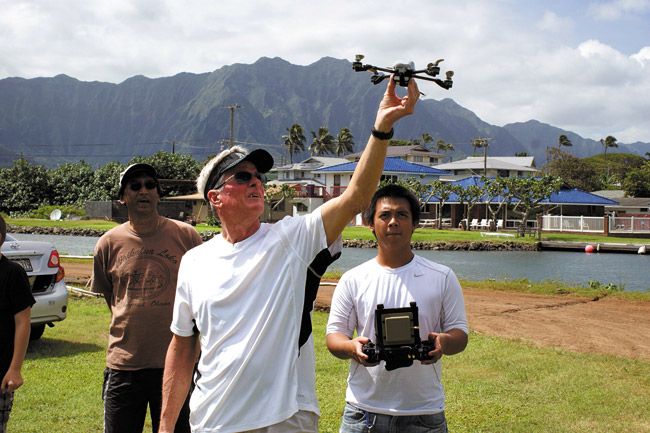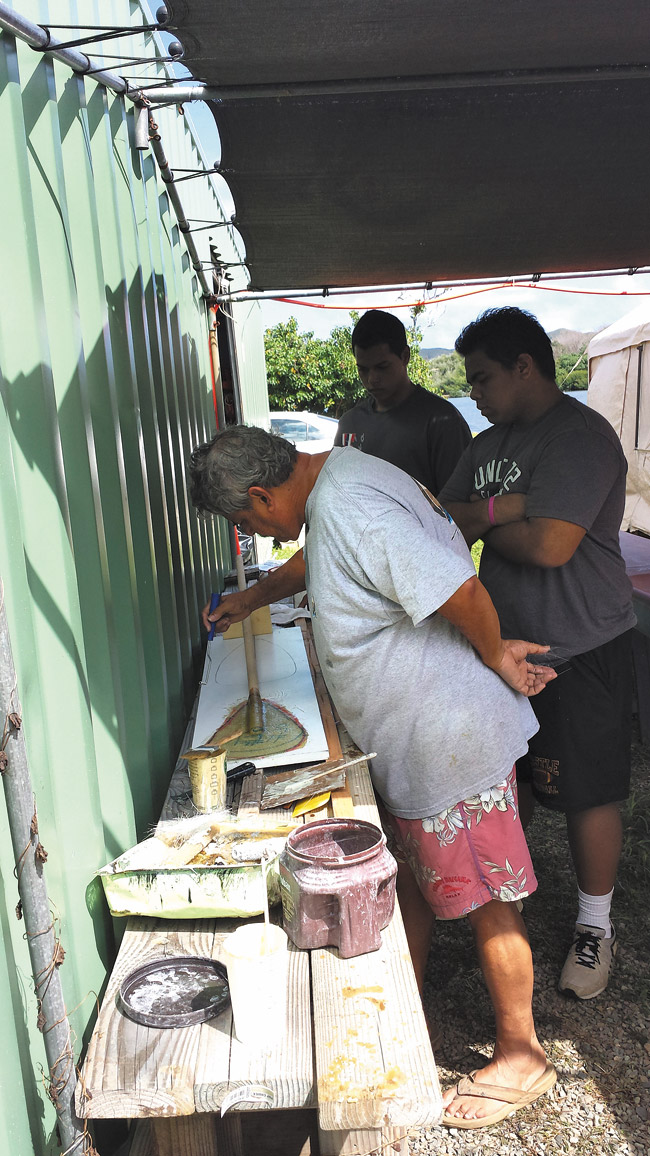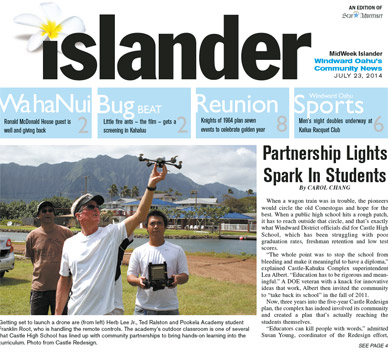Partnership Lights Spark In Students

Getting set to launch a drone are (from left) Herb Lee Jr., Ted Ralston and Pookela Academy student Franklin Root, who is handling the remote controls. The academy’s outdoor classroom is one of several that Castle High School has lined up with community partnerships to bring hands-on learning into the curriculum. Photo from Castle Redesign.
When a wagon train was in trouble, the pioneers would circle the old Conestogas and hope for the best. When a public high school hits a rough patch, it has to reach outside that circle, and that’s exactly what Windward District officials did for Castle High School, which has been struggling with poor graduation rates, freshman retention and low test scores.
“The whole point was to stop the school from bleeding and make it meaningful to have a diploma,” explained Castle-Kahuku Complex superintendent Lea Albert. “Education has to be rigorous and meaningful.” A DOE veteran with a knack for innovative ideas that work, Albert then invited the community to “take back its school” in the fall of 2011.
Now, three years into the five-year Castle Redesign plan, the complex has indeed involved its community and created a plan that’s actually reaching the students themselves.
“Educators can kill people with words,” admitted Susan Young, coordinator of the Redesign effort, which steps away from words and plunges non-traditional learners into off-campus, hands-on experiences. “(This is where) they’ve found a connection that is meaningful to them,” Young said.
Kaneohe residents, parents and businesspeople were drawn to Albert’s initial public forums in 2011 and soon began lining up to help. “Our students are bright, but they don’t fit into a conventional classroom,” she would tell them. “Yet they thrive on site.”
Thus was born the Pookela Academy of 60 students placed at small, land-based learning communities: Waikalua and Heeia fishponds, Wind-ward Community College aquaponics lab, Luluku Farms, Papahana Kuaola, and also at a construction workshop. They are engaged as interns, earning high school credits via work-study. Some also have paid summer internships on Coconut Island with Hawaii Institute of Marine Biology.

Glenn Martin (left) shows Pookela Academy students Kamu Carbonell-Dias and Bronson Asiata some fiberglass-making techniques. Martin’s firm, Aina-Kai Consulting, builds canoes and does construction work. Photo from Castle Redesign.
There’s a waiting list now for academy programs, Albert said, and some of those reluctant learners are starting to graduate. “People are coming out of the woodwork to help,” she said, “and Pookela was ready.” Ready because of federal and local funding, willing teachers and dozens of helping hands throughout Kaneohe.
The teenagers plant taro, test water purity, fly drones, build rock walls — all without realizing that this fun stuff is what the DOE has endorsed as “project-based learning” and “curriculum enhancement through teacher-business partnerships.”
Besides volunteering their talents, community resources like Glenn Martin (making fiberglass) and Mark Paikuli Stride (growing, harvesting and pounding taro) work with the teachers on learning benchmarks, in and outside of class.
Others play equally vital roles under the Redesign umbrella — class speakers, project mentors, internship sponsors. After assisting at Luluku Farms, for example, retired civil servant Herman Takeshi Toma provided four $600 UH scholarships this year to Pookela students. Herb Lee Jr., a King Intermediate alumnus, heads Castle Redesign’s anchor agency, developing curriculum and hosting Waikalua fishpond learning stations as executive director of Pacific American Foundation. Still others like Bernice Bowers, Marlene Zeug and Karen Kimura keep the school-community network ticking and growing.
Albert’s goal is to see 200 to 300 seniors placed in internships, earning credits and becoming college-ready. Also started or in the works: a Castle Complex alumni association, freshman parents group, a second online video updating Redesign for the public, and career/technical support at the elementary schools.
At its Pookela banquet, Young noted, students spoke of their experiences: “One student said that while pounding poi, he connected with who he was and was just really proud of himself, that possibly he wouldn’t have graduated without Pookela’s help.”
To keep up on the Redesign steamroller, view its Facebook page or call Young at 256-6182. Donors and volunteers with a skill to share always are welcome to help.






